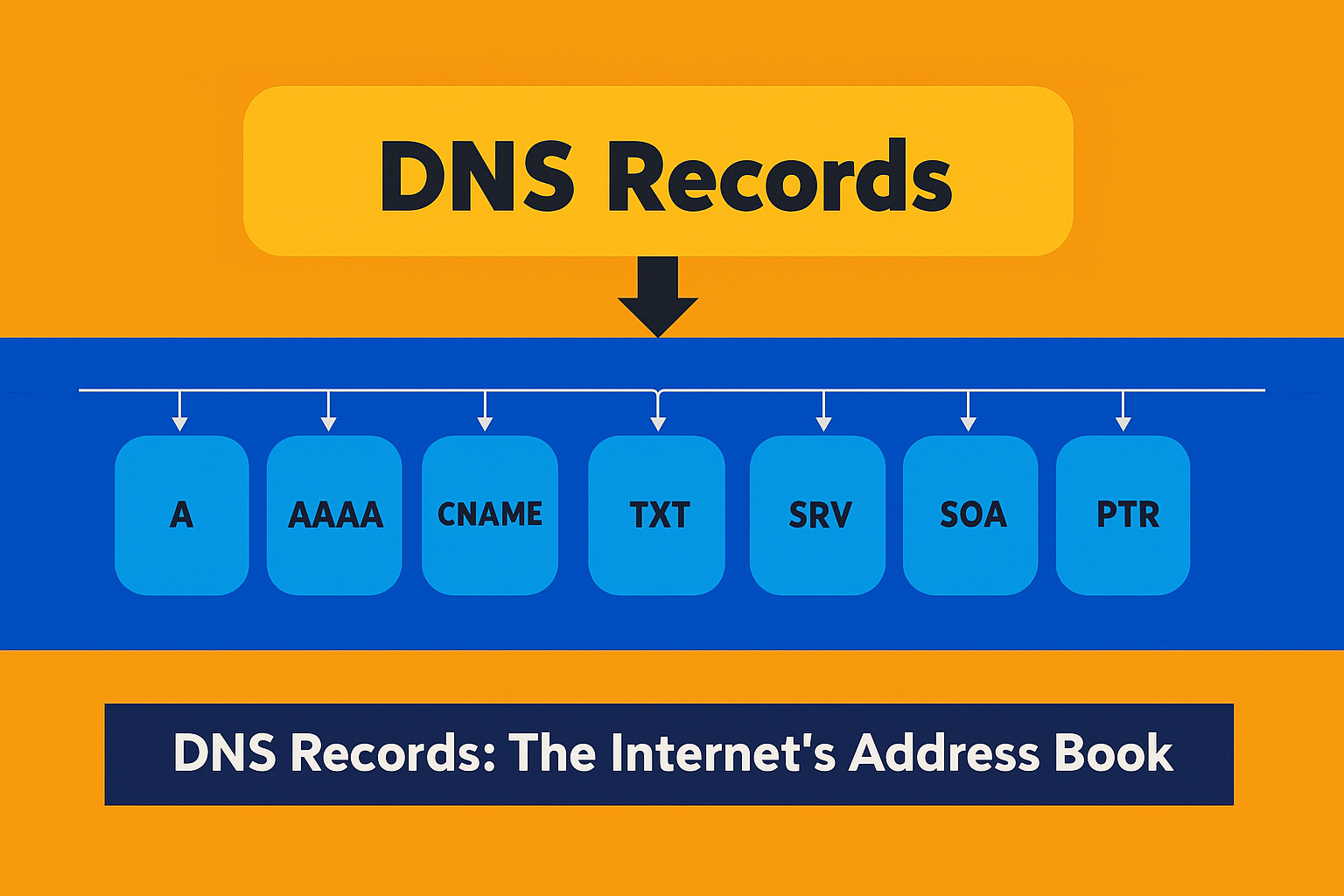DNS Records Explained: A, AAAA, CNAME, MX, TXT, SRV, SOA, NS, PTR
September 13, 2025 | by Free Site Hub

Comprehensive Guide to DNS Record Types and Their Functions
DNS (Domain Name System) records serve as the fundamental building blocks of internet navigation, acting as the phonebook of the internet that translates human-readable domain names into machine-readable IP addresses. Understanding DNS records is essential for website owners, system administrators, and anyone managing online services.
What Are DNS Records?
DNS records, also known as zone files, are textual instructions stored on authoritative DNS servers that provide critical information about a domain’s configuration. These records control how your domain name behaves, directing internet traffic and ensuring services like websites and emails function correctly.
Key Functions of DNS Records:
- Domain name resolution (translating domains to IP addresses)
- Service location specification (web, email, VoIP)
- Traffic direction and routing
- Domain verification and security authentication
- DNS zone configuration and management
Core DNS Record Types Explained
A Record (Address Record)
The A record is the most fundamental DNS record type, mapping a domain name to an IPv4 address.
Key Characteristics:
- Points domains/subdomains to IPv4 addresses (e.g., 192.0.2.1)
- Essential for basic website connectivity over IPv4
- Required for every domain accessible via IPv4
Example Usage:www.example.com → 203.0.113.45
AAAA Record (IPv6 Address Record)
The AAAA record serves the same purpose as an A record but for IPv6 addresses, which are longer and more complex than IPv4 addresses.
Key Characteristics:
- Maps domains to 128-bit IPv6 addresses (e.g., 2001:db8::1)
- Enables IPv6 compatibility for modern internet infrastructure
- Can coexist with A records for dual-stack support
Example Usage:www.example.com → 2001:db8:85a3::8a2e:370:7334
CNAME Record (Canonical Name Record)
CNAME records create aliases that point one domain name to another canonical domain name rather than directly to an IP address.
Key Characteristics:
- Creates domain aliases (points to another domain name)
- Simplifies DNS management when multiple names point to same destination
- Cannot coexist with other record types for the same hostname
Example Usage:blog.example.com → www.example.com
MX Record (Mail Exchange Record)
MX records direct email messages to the correct mail servers responsible for accepting emails for a domain.
Key Characteristics:
- Specifies mail servers for email delivery
- Includes priority values (lower numbers = higher priority)
- Must point to a domain name, not directly to an IP address
- Multiple MX records provide redundancy
Example Usage:example.com → ASPMX.L.GOOGLE.COM (priority 1)
TXT Record (Text Record)
TXT records store text-based information associated with a domain for various purposes including verification and security.
Key Characteristics:
- Stores arbitrary text data
- Used for domain verification (Google Search Console, etc.)
- Implements email authentication (SPF, DKIM, DMARC)
- Flexible format for various administrative purposes
Example Usage:example.com → "v=spf1 include:_spf.google.com ~all"
SRV Record (Service Record)
SRV records specify the location of specific services such as VoIP, instant messaging, or other custom protocols.
Key Characteristics:
- Locates servers for specific services
- Defines service name, protocol, and port number
- Includes priority and weight values for load balancing
- Used for services beyond web and email
Example Usage:_sip._tcp.example.com → sipserver.example.net (port 5060)
SOA Record (Start of Authority Record)
The SOA record contains essential administrative information about a DNS zone and is mandatory for every DNS zone.
Key Characteristics:
- Stores zone administration information
- Includes primary name server, admin email, and serial number
- Contains refresh, retry, expire, and TTL timers
- Exactly one SOA record required per DNS zone
Example Usage:example.com → ns.example.com admin.example.com (2023102701 3600 1800 1209600 3600)
NS Record (Name Server Record)
NS records delegate a DNS zone to authoritative name servers, indicating which servers hold the DNS information for a domain.
Key Characteristics:
- Delegates DNS zones to authoritative name servers
- Multiple NS records provide redundancy
- Used for zone delegation to different DNS providers
- Essential for DNS hierarchy and query resolution
Example Usage:example.com → ns1.examplehosting.com, ns2.examplehosting.com
PTR Record (Pointer Record)
PTR records perform reverse DNS lookups, mapping IP addresses back to domain names.
Key Characteristics:
- Reverse of A and AAAA records (IP to domain mapping)
- Stored in special reverse DNS zones
- Used for email server verification and network troubleshooting
- Important for security and authentication purposes
Example Usage:203.0.113.45 → webserver.example.com
DNS Records Comparison Table
| Record Type | Primary Function | Points To | Common Use Cases |
|---|---|---|---|
| A | IPv4 address mapping | IPv4 address | Website hosting (IPv4) |
| AAAA | IPv6 address mapping | IPv6 address | Website hosting (IPv6) |
| CNAME | Domain alias | Another domain name | Subdomains, redirection |
| MX | Mail exchange | Mail server domain | Email delivery |
| TXT | Text information | Text string | Verification, SPF, DKIM |
| SRV | Service location | Service hostname & port | VoIP, IM, custom services |
| SOA | Zone authority | Admin info, timers | DNS zone administration |
| NS | Name server delegation | Name server hostname | DNS zone delegation |
| PTR | Reverse DNS lookup | Domain name | Email verification, troubleshooting |
DNS Records and Web Hosting
DNS records are intrinsically linked to web hosting services. Proper DNS configuration is essential for:
Website Setup: A and AAAA records point your domain to your web hosting server’s IP address, making your website accessible via your domain name.
Email Configuration: MX records direct email to your email hosting provider’s mail servers, ensuring proper email delivery.
Subdomain Management: A, AAAA, or CNAME records enable the creation of subdomains (blog.example.com, shop.example.com) pointing to specific services or servers.
Domain Delegation: NS records at your domain registrar point to your hosting provider’s name servers, delegating DNS control to your hosting provider.
DNS Propagation: Changes to DNS records require time to propagate across the global DNS system, typically taking a few hours to complete worldwide.
Common DNS Record Problems and Solutions
Website Inaccessible:
- Cause: Incorrect A or AAAA records
- Solution: Verify IP addresses in A/AAAA records match your web server’s IP
Email Delivery Issues:
- Cause: Missing or incorrect MX records
- Solution: Implement proper MX records with correct priority values
CNAME Conflicts:
- Cause: Other record types conflicting with CNAME records
- Solution: Avoid placing other records on hostnames with CNAME records
Slow Propagation:
- Cause: DNS caching across the internet
- Solution: Allow 24-48 hours for full propagation; use lower TTL values before changes
Syntax Errors:
- Cause: Typos or incorrect formatting in DNS records
- Solution: Double-check record syntax and values before saving
Incorrect NS Records:
- Cause: Nameservers not properly configured at registrar
- Solution: Ensure NS records at registrar point to correct authoritative nameservers
DNS Management Best Practices
- Use Lower TTL Values Before Changes: Reduce TTL (Time to Live) values several days before making DNS changes to speed up propagation
- Verify Record Syntax: Always double-check DNS record formatting and values
- Implement Redundancy: Use multiple records (MX, NS) for critical services
- Document Changes: Maintain a change log for DNS modifications
- Use DNSSEC: Implement DNS Security Extensions for enhanced security
- Regular Audits: Periodically review DNS records for accuracy and necessity
Related DNS Concepts
Domain Name System (DNS): The hierarchical decentralized naming system for computers, services, or other resources connected to the Internet.
IP Addresses: Numerical labels assigned to each device connected to a computer network that uses the Internet Protocol for communication.
IPv4 vs IPv6: IPv4 uses 32-bit addresses (4.3 billion possible), while IPv6 uses 128-bit addresses (340 undecillion possible).
Name Server: Server that implements the DNS protocol, storing DNS records and responding to DNS queries.
DNS Propagation: The time it takes for DNS changes to update across all DNS servers worldwide.
TTL (Time to Live): A value in DNS records that determines how long the record should be cached by resolvers.
FAQ About DNS Records
What are DNS records used for?
DNS records provide instructions that control how domains behave, directing internet traffic, enabling email delivery, and providing verification mechanisms.
How long do DNS changes take to propagate?
DNS changes typically take 4-24 hours to fully propagate globally, though this can vary based on TTL values and ISP policies.
Can I have multiple A records for one domain?
Yes, multiple A records can be used for load balancing or redundancy purposes.
What’s the difference between A and CNAME records?
A records point directly to IP addresses, while CNAME records point to other domain names (aliases).
Do I need both A and AAAA records?
While not strictly necessary, having both records ensures your website is accessible via both IPv4 and IPv6 connections.
How do MX record priorities work?
Lower priority values indicate preferred mail servers. The server with the lowest priority value is tried first.
What is reverse DNS?
Reverse DNS (rDNS) is the process of mapping IP addresses back to domain names using PTR records.
Where do I manage my DNS records?
DNS records can typically be managed through your domain registrar’s control panel or your web hosting provider’s DNS management interface.
What is TTL in DNS records?
TTL (Time to Live) specifies how long DNS resolvers should cache the record before checking for updates.
How do I verify my DNS changes worked?
Use DNS lookup tools like dig, nslookup, or online DNS checking tools to verify your DNS records are propagating correctly.
Understanding DNS records is essential for managing your online presence effectively. Proper DNS configuration ensures your website is accessible, your emails are delivered, and your online services function correctly.
RELATED POSTS
View all


